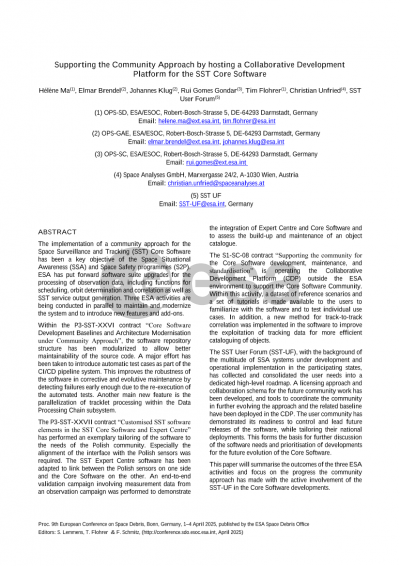Document details

Abstract
The implementation of a community approach for the Space Surveillance and Tracking (SST) Core Software has been a key objective of the Space Situational Awareness (SSA) and Space Safety programmes. ESA has put forward software suite upgrades for the processing of observation data, including functions for scheduling, orbit determination and correlation as well as SST service output generation. Three ESA activities are being conducted in parallel to maintain and modernize the system and to introduce new features and add-ons.
Within the P3-SST-XXVI contract “Core Software Development Baselines and Architecture Modernisation under Community Approach”, the software repository structure has been modularized to allow better maintainability of the source code. A major effort has been taken to introduce automatic test cases as part of the CI/CD pipeline system. This improves the robustness of the software in corrective and evolutive maintenance by detecting failures early enough due to the re-execution of the automated tests. Another main new feature is the parallelization of tracklet processing within the Data Processing Chain subsystem.
The P3-SST-XXVII contract “Customised SST software elements in the SST Core Software and Expert Centre” has performed an exemplary tailoring of the software to the needs of the Polish community. Especially the alignment of the interface with the Polish sensors was required. The SST Expert Centre software has been adapted to link between the Polish sensors on one side and the Core Software on the other. An end-to-end validation campaign involving measurement data from an observation campaign was performed to demonstrate the integration of Expert Centre and Core Software and to assess the build-up and maintenance of an object catalogue.
The S1-SC-08 contract “Supporting the community for the Core Software development, maintenance, and standardisation” is operating the Collaborative Development Platform (CDP) outside the ESA environment to support the Core Software Community. Within this activity, a dataset of reference scenarios and a set of tutorials is made available to the users to familiarize with the software and to test individual use cases. In addition, a new method for track-to-track correlation was implemented in the software to improve the exploitation of tracking data for more efficient cataloguing of objects.
The SST User Forum (SST-UF), with the background of the multitude of SSA systems under development and operational implementation in the participating states, has collected and consolidated the user needs into a dedicated high-level roadmap. A licensing approach and collaboration schema for the future community work has been developed, and tools to coordinate the community in further evolving the approach and the related baseline have been deployed in the CDP. The user community has demonstrated its readiness to control and lead future releases of the software, while tailoring their national deployments. This forms the basis for further discussion of the software needs and prioritisation of developments for the future evolution of the Core Software.
This paper will summarise the outcomes of the three ESA activities and focus on the progress the community approach has made with the active involvement of the SST-UF in the Core Software developments.
Preview








